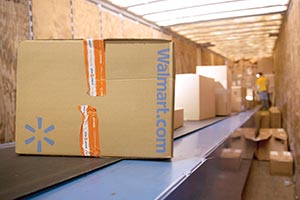Carriers, Retailers Struggle to Absorb Costs From Free Shipping for Online Purchases

This story appears in the Feb. 16 print edition of Transport Topics.
CORAL GABLES, Fla. — The surge in electronic commerce from customers who are seeking free delivery is taxing delivery companies and retailers alike, forcing them to figure out how to absorb the expense.
That was the unanimous view of panelists — carriers, retailers and industry experts — at last week’s BB&T Capital Markets conference.
What e-commerce has done is created a huge spike, with as much as 60% more shipments on two or three days a year, said Satish Jindel, who heads SJ Consulting.
“That creates a huge operational challenge,” he said.
Jindel cited the $200 million reduction in profit at UPS Inc. after that company “went overboard” to add 17% more workers for a peak season when shipments increased by just 9%.
“There is no such thing as free shipping,” Jindel said, “but everyone wants to find ways to capitalize on that idea. At some point, you have to recover the cost.”
But Ken Braunbach, vice president of e-commerce for Wal-Mart Stores Inc., said “Free shipping is something all retailers need to provide. We deliver millions of packages with free shipping.”
At the same time, he acknowledged that “there is no such thing as free shipping” from a cost standpoint, which forces retailers to account for the cost when peak holiday season volumes surge, as they did at Wal-Mart, climbing 34%.
To illustrate different approaches and the cost factor, he used the example of a family member who had to choose between a $141 weight set with free shipping and his company’s price of $90 plus $49 in shipping expense.
There are other ways to view free shipping, said Rob Howard, CEO of package delivery consulting firm Grand Junction.
He believes companies such as Amazon.com have taken shipping costs out of the transportation budget. Amazon.com, he said, views that $500 million of annual delivery cost as a marketing expense.
Mark Magill, vice president of regional package delivery carrier OnTrac, said he thinks that younger buyers are focused on convenience and won’t be dissuaded from using e-commerce even if cost is added to it. Several panelists noted that the rise in e-commerce doesn’t necessarily spill over into the ability to perform same-day deliveries.
Braunbach noted that 7,000 products sold at Wal-Mart are available for same-day delivery in some markets, where the assets and inventory can be leveraged to accomplish that.
“Same-day delivery is a lot different in West Texas and Boston,” he said, because one market can support same day, and the far-flung Texas market can’t.
Braunbach noted that Wal-Mart is trying some new approaches to same-day delivery, including placing storage lockers at stores in Phoenix to make pickups more convenient.
Magill isn’t convinced that same-day delivery will become common.
Jindel believes the same-day market is limited because only 2% of customers are willing to pay for that faster service.
“The consumer is still looking for free shipping,” he said. “Unless it comes faster for free, customers don’t want to pay for it.”
Jindel also sees little demand for same-day delivery, except for pizza and Chinese food.
Others do not agree.
Howard believes that same-day deliveries will become a standard, with orders placed by early morning that are delivered in the afternoon.
Companies such as Amazon.com will be able to make those deliveries as they move their distribution centers closer to customers. The only shipping premium, he said, will be paid for even faster deliveries, such as one hour after ordering.
Jindel also noted another change that parcel companies are making to address a different sort of free shipping. Package delivery companies are shifting to dimensional pricing because they aren’t being properly compensated as some customers “ship air,” he said.

